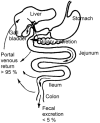Exploitation of bile acid transport systems in prodrug design
- PMID: 17960093
- PMCID: PMC6149114
- DOI: 10.3390/12081859
Exploitation of bile acid transport systems in prodrug design
Abstract
The enterohepatic circulation of bile acids is one of the most efficient recycling routes in the human body. It is a complex process involving numerous transport proteins, which serve to transport bile acids from the small intestine into portal circulation, from the portal circulation into the hepatocyte, from the hepatocyte into the bile, and from the gall bladder to the small intestine. The tremendous transport capacity and organ specificity of enterohepatic circulation combined with versatile derivatization possibilities, rigid steroidal backbone, enantiomeric purity, availability, and low cost have made bile acids attractive tools in designing pharmacological hybrid molecules and prodrugs with the view of improving intestinal absorption, increasing the metabolic stability of pharmaceuticals, specifically targeting drugs to organs involved in enterohepatic circulation, as well as sustaining therapeutically reasonable systemic concentrations of active agents. This article briefly describes bile acid transport proteins involved in enterohepatic circulation, summarizes the key factors affecting on the transport by these proteins, and reviews the use of bile acids and their derivatives in designing prodrugs capable of exploiting the bile acid transport system.
Figures














Similar articles
-
Bile acids: chemistry, pathochemistry, biology, pathobiology, and therapeutics.Cell Mol Life Sci. 2008 Aug;65(16):2461-83. doi: 10.1007/s00018-008-7568-6. Cell Mol Life Sci. 2008. PMID: 18488143 Free PMC article. Review.
-
Apical sodium dependent bile acid transporter (ASBT, SLC10A2): a potential prodrug target.Mol Pharm. 2006 May-Jun;3(3):223-30. doi: 10.1021/mp060022d. Mol Pharm. 2006. PMID: 16749855 Free PMC article. Review.
-
Biological and medical aspects of active ileal transport of bile acids.Ann Med. 1991 Apr;23(2):169-75. doi: 10.3109/07853899109148043. Ann Med. 1991. PMID: 2069793
-
Bile acid derived HMG-CoA reductase inhibitors.Biochim Biophys Acta. 1994 Nov 29;1227(3):137-54. doi: 10.1016/0925-4439(94)90088-4. Biochim Biophys Acta. 1994. PMID: 7986821
-
Nuclear receptor control of enterohepatic circulation.Compr Physiol. 2012 Oct;2(4):2811-28. doi: 10.1002/cphy.c120007. Compr Physiol. 2012. PMID: 23720266 Free PMC article. Review.
Cited by
-
A novel bioluminescence-based method to investigate uptake of bile acids in living cells.Am J Physiol Gastrointest Liver Physiol. 2018 Oct 1;315(4):G529-G537. doi: 10.1152/ajpgi.00133.2018. Epub 2018 Jun 21. Am J Physiol Gastrointest Liver Physiol. 2018. PMID: 29927324 Free PMC article.
-
Bile acid transporter-mediated oral drug delivery.J Control Release. 2020 Nov 10;327:100-116. doi: 10.1016/j.jconrel.2020.07.034. Epub 2020 Jul 22. J Control Release. 2020. PMID: 32711025 Free PMC article. Review.
-
The effect of a tertiary bile acid, taurocholic acid, on the morphology and physical characteristics of microencapsulated probucol: potential applications in diabetes: a characterization study.Drug Deliv Transl Res. 2015 Oct;5(5):511-22. doi: 10.1007/s13346-015-0248-9. Drug Deliv Transl Res. 2015. PMID: 26242686
-
Therapeutic Effect of Chenodeoxycholic Acid in an Experimental Rabbit Model of Osteoarthritis.Mediators Inflamm. 2015;2015:780149. doi: 10.1155/2015/780149. Epub 2015 Oct 11. Mediators Inflamm. 2015. PMID: 26538834 Free PMC article.
-
Role of the intestinal bile acid transporters in bile acid and drug disposition.Handb Exp Pharmacol. 2011;(201):169-203. doi: 10.1007/978-3-642-14541-4_4. Handb Exp Pharmacol. 2011. PMID: 21103970 Free PMC article. Review.
References
-
- St-Pierre M.V., Kullak-Ublick G.A., Hagenbuch B., Meier P.J. Transport of bile acids in hepatic and non-hepatic tissues. J. Exp. Biol. 2001;204:1673–1686. - PubMed
-
- Hofmann A. In: The Liver: Biology and Pathobiology. Arias I.M., Jakoby W.B., Popper H., Schachter D., Shafritz D.S, editors. Raven Press; New York: 1988. pp. 553–572.
-
- Carey M.C., Cahalane M.J. In: The Liver: Biology and Pathobiology. Arias I.M., Jakoby W.B., Popper H., Schachter D., Shafritz D.S., editors. Raven Press; New York: 1988. pp. 573–616.
-
- Turley D.S., Dietschy J.M. In: The Liver: Biology and Pathobiology. Arias I.M., Jakoby W.B., Popper H., Schachter D., Shafritz D.S, editors. Raven Press; New York: 1988. pp. 617–641.
Publication types
MeSH terms
Substances
LinkOut - more resources
Full Text Sources
Other Literature Sources

